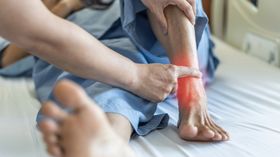Achilles Tendinopathy vs. Tendonitis: Differences and Definitions
Updated December 19, 2024

Tendinopathy and tendonitis are two types of Achilles tendon pain and are often confused as their symptoms are extremely similar, and the injury occurs in the same region. Both conditions cause pain at the insertion point of the tendon or along the length of the tendon and are associated with exercise exertion.
However, they are two different conditions with several distinctions. Where tendinopathy is a breakdown of the protein fibers making up the tendon, tendonitis refers to inflammation of the tendon.
What Is Tendinopathy?
Achilles tendinopathy is characterized by the degeneration of the collagen fibers that make up the tendon. Micro-tears in the fibers are often caused by overexertion or repetitive strain on the tendon through running or jumping activities. This condition points to a tissue disorder, namely repetitive damage to the tendon, which fails to heal adequately.
This condition also commonly occurs in the shoulder, elbow, and wrist. With time and rest, the symptoms usually subside. In severe cases, where adequate time for collagen fiber healing has not taken place, severe injury or rupture can occur to the tendon due to the ongoing breakdown of the collagen fibers. Surgical intervention is then required to manage the condition effectively.
What Is Tendonitis?
Tendonitis, especially in the Achilles tendon, is marked by pain and inflammation in the tendon. The tendon becomes irritated and can feel painful due to the regular and repetitive strain placed on the Achilles tendon from walking or running. Point tenderness, warmth, and swelling over the inflamed tendon are common. Pain is associated with Achilles tendonitis and is commonly caused by activity and exertion as well.
Achilles tendonitis usually occurs at the insertion point of the tendon with the calcaneus bone, known as insertional Achilles tendonitis. This is the likely spot for pain and discomfort to occur.
Differences Between Tendinopathy and Tendonitis
1. Causes
Achilles tendinopathy:
- Running on hard surfaces
- Repetitive running or jumping activities
- Calcium deposits in the tendon
- High loads out through the tendon
- Heel bone spurs
- Poor lower leg and ankle biomechanics
Achilles tendonitis:
- Sudden injury to the tendon, usually as a result of high loads
- Repetitive movements that place strain on the tendon
- Poor posture and lower leg biomechanics
2. Symptoms
Achilles tendinopathy:
- Pain or a burning sensation in the Achilles tendon
- Difficulty moving the joint due to stiffness and associated pain
- Muscle weakness
- Pain in the area when rising onto the toes
- Swelling notes in the area of the Achilles tendon
- In severe cases, reduced mobility and high levels of pain
Achilles tendonitis:
- Pain or discomfort at the insertion point of the Achilles tendon or in the middle of the tendon fibers
- Swelling in the area
- Pain when touching the inflamed area
- Bony prominence forming on the heel bone
- Stiffness in the tendon and ankle joint
- In severe cases, reduced mobility due to pain
- In severe cases, high levels of pain are associated with damage to the fibers of the tendon
3. Treatment
The treatment goals for both conditions are to reduce inflammation and pain and improve overall mobility. The following are the primary treatment strategies:
Ice
Applying ice to the affected area effectively reduces inflammation during the acute phases of pain.
Orthotics
Wearing orthotics in your shoes can be very helpful in combating the symptoms arising from these conditions. Orthotic insoles support the foot and ankle while distributing the weight evenly through the entire foot, lessening the strain on the Achilles tendon.
Stretching
Stretching the calf muscle is another excellent way to manage both conditions and prevent them from worsening.
Achilles Tendon Exercises
Exercises for the Achilles tendon are beneficial in strengthening the tendon's fibers and muscles around the area for increased stability. Heel raises, resistance TheraBand exercises, and range of motion exercises are all helpful in managing this condition effectively. Exercises should only be done if there is no pain in the heel area.
Activity Modification
Not overexerting yourself or doing too much too soon is vital to prevent exacerbating the problem. When running with Achilles tendonitis, it's advised to start slowly with minimal exertion and gradually increase the amount of exercise you do. Allow time for your body to recover from exercise sessions to avoid injuring the tendons and causing unwanted symptoms.
4. Prevention
In combination with orthotics and stretching, rest can effectively prevent Achilles tendonitis and tendinopathy. Gently massaging the Achilles tendon can help align the tendon's healing collagen fibers. Massage can be applied lengthways along the tendon for maximum benefit.








